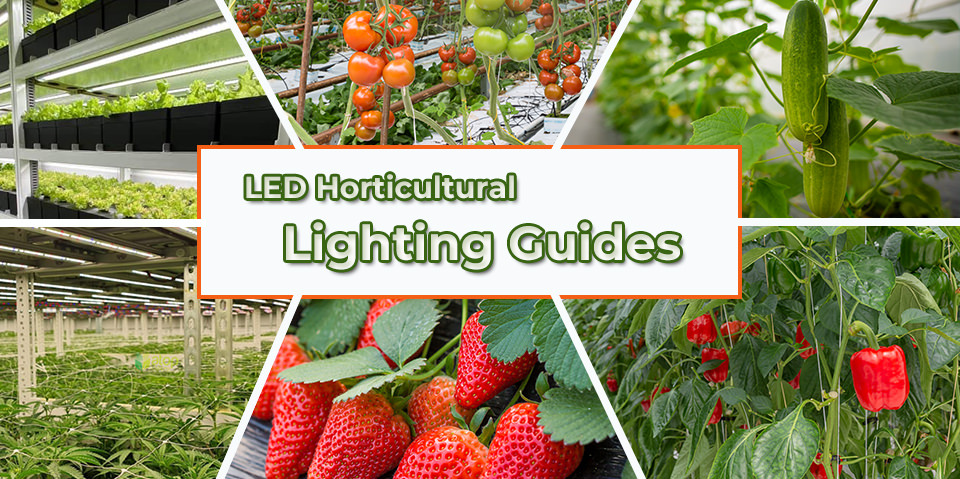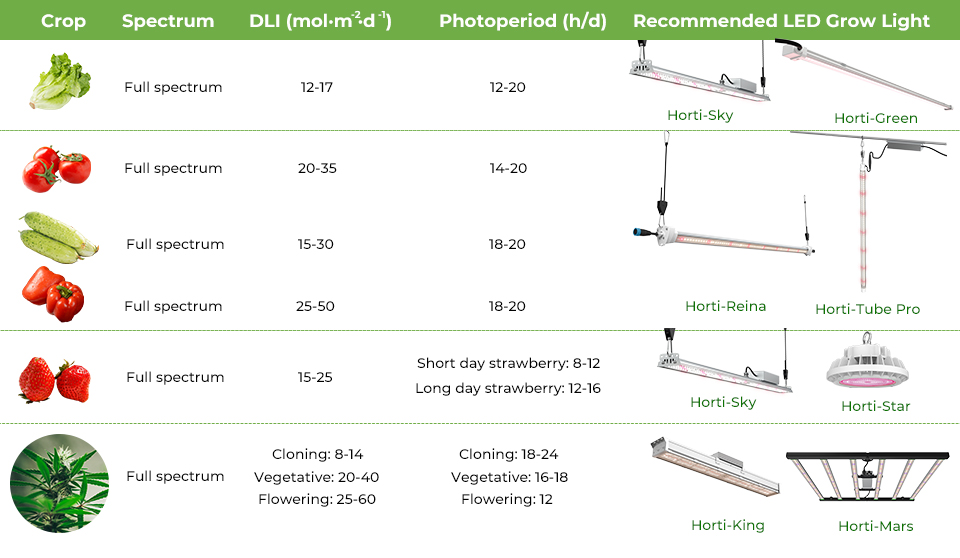LED Horticultural Lighting Guides to 6 Common Commercial Crops

In recent years, greenhouse cultivation and vertical farming are becoming more and more popular. Some crops are being able to cultivate in large scale and commercial production. From controlling the growing environment precisely for crops, they not only produce more food for humans, but also save the lands and spaces. Regardless of greenhouse or indoor vertical farms, light is one of the key factors of growing environment that affects the growth of crops. Since the lighting strategies depends on multiple factors, such as cultivars, planted locations, and growing stages of crops, providing appropriate light for crops is complex and difficult for most growers. This post would like to show you the lighting guides to 6 common commercial crops. Though there are various grow light types in the market, LED grow lights stand out from others due to their low energy consumption, long lifespan, and high efficiency. LED grow lights are used as sole light source for indoor vertical farms and the supplemental light source for the greenhouse. Therefore, the lighting guides in this post are based on LED grow lights. The six common commercial crops are lettuce, tomatoes, cucumber, pepper, strawberry, and hemp.
Before showing the lighting guides of the crops, let’s learn three basic concepts that related to the performance of LED lights - light spectrum, DLI, and photoperiod. Light spectrum of LED grow lights determines whether the light is beneficial for photosynthesis, while the DLI decides how much light is absorbed by crops that provides photosynthetic activation. Photoperiod plays an important role in the duration of light for crops. If you already know them very well, just skip this part and find the lighting guides for your interested crops.
Here is a short table of the effects of three light spectra on crops.
|
Light Spectra |
Blue Light (400 - 500 nm) |
Red light (600 - 700 nm) |
Far-red light (700 - 850 nm) |
|
Effects |
Beneficial for crop growth and morphology Drive root development Support nutrient production |
Important for flowering Driver plant growth Efficient in chlorophyll absorption |
Beneficial for flowering Improve the photosynthetic efficiency
|
DLI is more complex than the light spectrum. It is the most important metric for crop growth. But the measure of DLI is affected by various factors, like the light transmission and the position of sensor. For more detailed about DLI, please click here and read the previous post about DLI.
Photoperiod is related to the flowering of most crops. Photoperiod in a summer day is longer than the winter day. Generally, long day crops initiate flowering with the photoperiod at least 12 hours. In contrast, short day crops flower with a shorter photopriod which is less than 12 hours. The function of LED grow light is to regulate the photoperiod of crop, stimulating the flowering.
Lettuce
Lettuce is a low-light crop. LED grow lights with full spectrum are ideal for lettuce. Increasing DLI can active growth and improve shoot fresh fresh and dry mass. But excessive DLI (DLI higher than 17 mol·m-²·d-¹) can result disorder like leaves tipburn. DLI ranged from 12 mol·m-²·d-¹ to 17 mol·m-²·d-¹ is recommended for lettuce farming. A photoperiod between 12 and 20 hours is suitable for lettuce. But the specific value depends on your goals. Shorter light cycle results round shape and higher planting density, while longer light cycle causes slender leaves.
Tomato
Tomato needs a large amount of light and higher light intensity. LED grow lights with full spectrum contribute to robust growth. DLI(Daily Light Integral) around 30 mol·m-²·d-¹ enables tomatoes produce high yields. But the available sunlight in a greenhouse is only 25 mol·m-²·d-¹ in common. Thus, it is critical to supplement light for the crops. Another problem is the uniform DLI distribution caused by the leaf shade. Upper leaves shade the lower leaves, and cause insufficient light to the lower leaves. The most effective way to solve the problem is to utilize a vertical 360 degree inter-lighting LED grow light, which can provide uniform light from top to the bottom for tomatoes plants. Tomatoes requires a longer photoperiod about 14 - 20 hours.
Cucumber
Similar to tomatoes, cucumber also needs a lot of light and faces with the same problem due to their tall plants. Full spectrum LED grow lights help to achieve higher yield and earlier harvest. Research shown that LED supplemental light increased about 80% yield compared to the solely natural light condition. Moreover, the harvest time was forwarded over 2 weeks. A vertical 360 degree inter-lighting LED grow light is also recommended for growing cucumber. The optimum DLI for cucumber is about 30 mol·m-²·d-¹, and the DLI should not less than 15 mol·m-²·d-¹. A photoperiod about 18 - 20 hours can meet the needs of cucumber.
Pepper
Pepper is a warm season and slow-growing crop. It is a high-light crop as well. Full spectrum LED grow lights fulfill the needs throughout the whole life cycle of pepper. Red/ far red light influence phytochrome content while UV-A and blue light have effects on Cytochrome. Small amount of far-red light promotes fruit production to greenhouse peppers. For generative growth, DLI ranged from 25 to 50 mol·m-²·d-¹ is required. With sufficient light, the pepper production can be increased by 18% to 33%. A photoperiod between 18 and 20 hours but not over 21 hours is perfect to pepper production.
Strawberry
Strawberry has a much lower lighting requirement than vine crops. Strawberries are classified into June-bearing strawberries, everbearing strawberries and day-neutral strawberries, according to their flowering habits. Jun-bearing strawberries flower in short day periods and initiate to bear fruit in June (early summer). Everbearing strawberries have two harvests, June and late summer. LED grow lights with full spectrum is recommended enhancing photosynthesis. DLI of 15 to 25 mol·m-²·d-¹ is optimum for greenhouse strawberries. Researches have shown that 8 hours photoperiod for short-day plants and 16 hours photoperiod for long-day plants could trigger earlier flowering. Thus, a photoperiod from 8 - 12 hours is optimal for short day strawberry while the 12 - 16 hours is ideal for long day strawberry.
Hemp
Hemp can only grow well in high-light conditions. It has been proved that far-red light could increase the hemp yield. And it was claimed that UV light could increase the cannabinoids production. Hemp can tolerant the DLI up to 60 mol·m-²·d-¹ in flowering stage. But its tolerance to DLI is as low as 8 mol·m-²·d-¹ in cloning stage. The main difference between hemp and other crops is the management of photoperiod. The photoperiod for cloning stage of hemp cannot less than 18 hours. When it comes to flowering stage, the photoperiod can be reduced to 12 hours.
To sum up, a table about the LED lighting guides for the 6 common crops is as followed:

